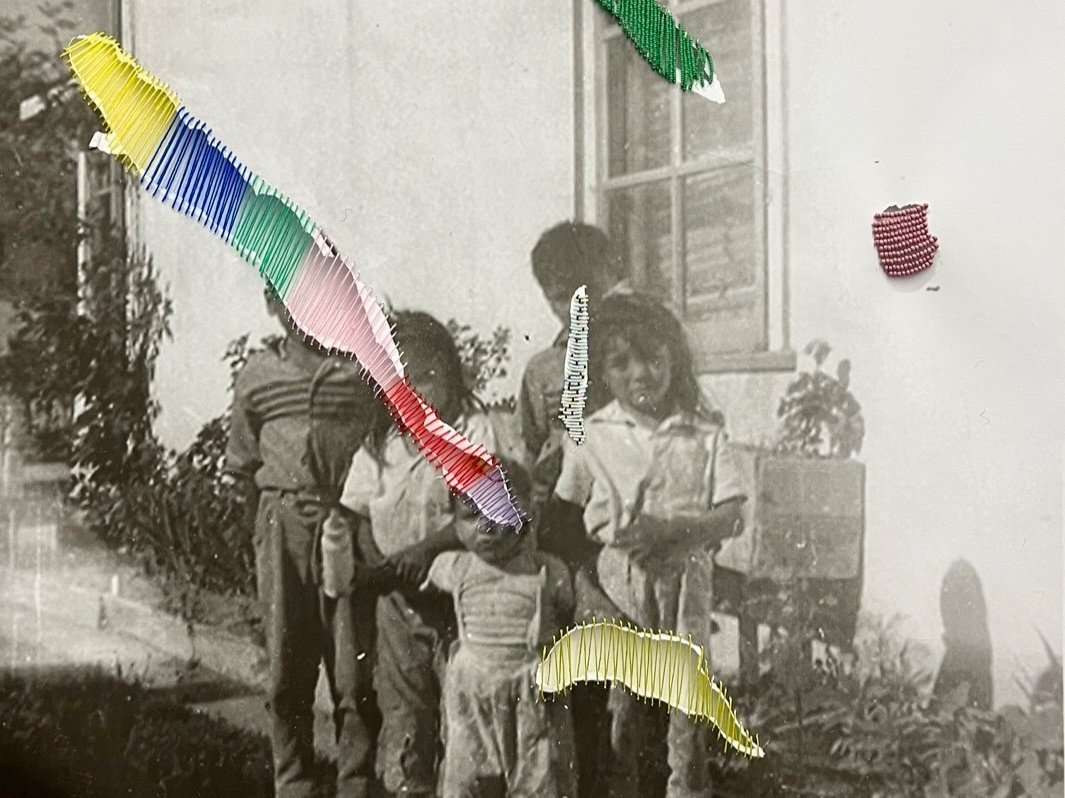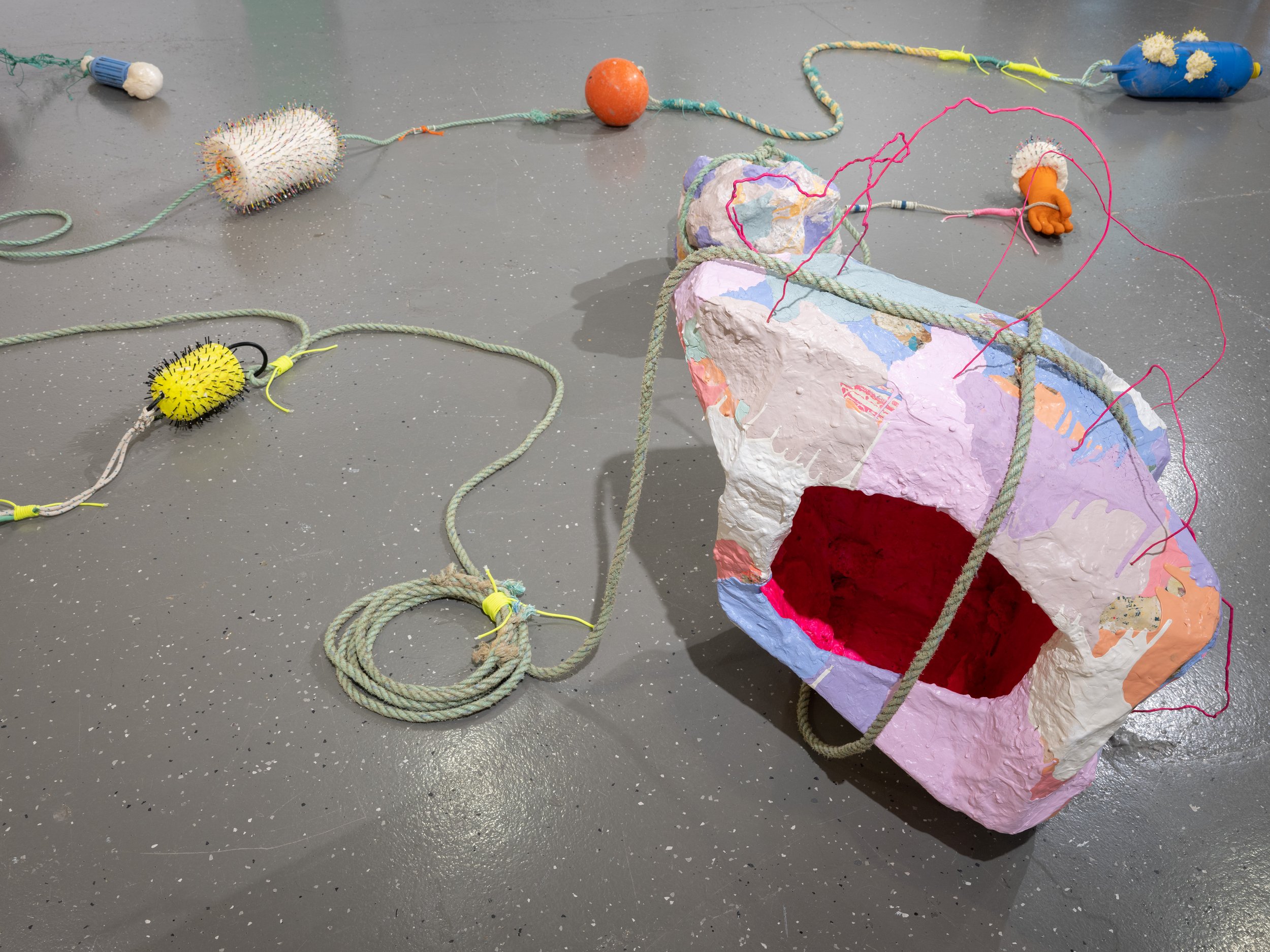
Michelle Sound // The Aunties That Do
The Aunties That Do explores personal and familial narratives with a consideration of Indigenous artistic processes. Michelle Sound's works explore cultural identities and histories by engaging materials and concepts within a contemporary context. Through utilizing such practices as drum making, caribou hair tufting, beadwork, and photography, her work highlights that acts of care and joy are situated in family and community. They work with traditional and contemporary materials and techniques to explore maternal labour, identity, cultural knowledge, and cultural inheritances. This exhibition is composed of four bodies of work:
Holding It Together uses archival images that contain loss, grief, longing and memory. The ripped images exhibit the colonial violence that Sound’s family, and other Indigenous families, have experienced including residential school intergenerational trauma, loss of language, and displacement from territories. These losses can never be fully healed but these histories and realities can be processed through art, culture and stories. The materials of these large 4x3’ artworks include paper, beadwork, embroidery thread, porcupine quills and caribou tufting.
Nimama hates fish but worked in the cannery is informed by Sound’s mother who is Cree from Kinuso, in northern Alberta and a member of Wapsewsipi (Swan River) First Nation. Her parents became enfranchised in the forties so their children would not be forced to attend residential school as they did. They no longer lived on their reserve and moved around Alberta looking for work. Her mom moved out to BC in the seventies, before Sound was born, for better employment opportunities. She worked in the Richmond cannery, even though she hated fish, as it was a necessity for her family’s survival. Their family has had to navigate a transition into new roles as guests on this territory. They live with a sense of displacement and loss of their community and language. Sound was the first of her family born on the west coast and now raises her son in the traditional, unceded territory of the xʷməθkwəy̓əm (Musqueam), Skwxwú7mesh (Squamish), and Selilwitulh (Tsleil-Waututh) Nations. As Sound explains, “this piece explores how we relate to the land we live on and also acknowledges our presence as visitors”. Nimama hates fish but worked in the cannery consists of three works, each 2.5x4’, digital print on cloth vinyl.
80’s Brat, in the Main Gallery of the Alternator, 2023.
80’s Brat is a series of drums that pay homage to the Aunties, a community of caretakers. As Sound explains, “our aunties are also our mothers, who take care of us, our 'cool' moms”. More often than not, the aunties are our first style icons, the loud aunties with the big laugh, who take us to the mall. This drum series is a tribute to their classic auntie style. Dimensions of this series vary, ranging from 8” - 22” in size.
HBC Trapline references the fur trade when beaver pelts were traded for one Hudson Bay Co. four-point blanket. These HBC blankets started to replace traditional blankets that were sewn together from rabbit furs. Indigenous women were vital to the fur trade and the preparation of furs. The four HBC colours of Blue, Yellow, Red, and Green acknowledge the ancestors who worked in the fur trade and the importance of the blanket and women's labour to the fur trade.
The Aunties That Do will be on view from May 19th - July 1st, 2023. Sound is also an artist in residence for this year’s Indigenous Art Intensive at the University Of British Columbia Okanagan. Learn more about the Intensive here.
“In collaboration with the Kelowna Métis Association , the Alternator Centre for Contemporary Art invites you to join us for an evening of beading and crafting.
On June 28th, from 6-8 pm, we will be hosting a Beading Circle in our Main Gallery space. Participants can enjoy working on beading projects while surrounded by the work of Cree and Métis artist Michelle Sound.
This event is free to attend and open to anyone. Participants are encouraged to bring their own beading project. However, supplies will be available for first-time beaders to create a beaded pin. Folks of all skill levels are welcome.
Please RSVP by visiting https://www.alternatorcentre.com/events/beading-circle
The Aunties that Do, featuring 80’s Brat and Holding It Together in the Main Gallery of the Alternator, 2023.
Michelle Sound is a Cree and Métis artist, educator and mother. She is a member of Wapsewsipi/Swan River First Nation in Northern Alberta, her maternal side is Cree and her paternal side is Métis from central Alberta. She holds a Bachelor of Fine Arts from Simon Fraser University, School for the Contemporary Arts, and a Master of Applied Arts from Emily Carr University Art + Design. Michelle is a 2021 Salt Spring National Art Award Finalist and has had recent exhibitions at Daphne Art Centre (Montréal), Neutral Ground ARC (Regina) and grunt gallery(Vancouver).
Learn more about Sound and her work, here.









